Thoroughly Modern Metrology
Thanks to a host of ease-of-use and accuracy improvements, a new generation of 3D scanners and portable CMMs are improving productivity and reducing costs.
Latest News
January 1, 2013
The combination of ease-of-use improvements, higher precision accuracy, and a narrowing price/performance curve is advancing the cause of 3D scanning as a means of modernizing and bolstering productivity for both quality inspection and reverse engineering applications across a growing range of manufacturers.
The newest generation of 3D scanners and related quality inspection and metrology software promises to deliver clear benefits over mechanical measurement processes, including traditional coordinate measurement machines (CMMs), experts say. Specifically, smoother workflows via integration with 3D CAD systems, ongoing improvements to ease operation, and continually evolving scanning speeds are helping engineers improve efficiency and quality for first article inspection applications—all while shaving hours (and dollars) from product development processes. This is particularly true for reverse engineering objects with complex geometries.
“There is definitely a trend toward more 3D scanning,” says David Olson, director of sales and marketing for Verisurf, a provider of a model-based definition metrology software suite that supports a range of metrology hardware, including laser trackers and scanners as well as stationary and portable CMMs. “You can capture many more points in a shorter amount of time, which can be very useful when you have organic shapes and ergonomic forms, like a pistol grip or an interface between a prosthetic device and a human body.”
Consumer interest in 3D technology, and specifically, a rising comfort level with products like Microsoft s Kinect gaming interface, which uses light to measure and display 3D virtual environments, is also drawing attention to the category. Metrology experts say that while Kinect and other consumer-driven 3D scanning technologies don t yet provide anywhere near the level of accuracy and precision required by industrial applications, they are increasing exposure to 3D scanning—thus helping to defuse change management issues that have historically impeded widespread adoption.
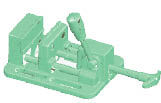 Scan data of the vise seen directly in Geomagic Spark s capture window. | 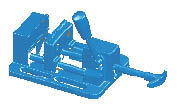 Automated creation of polygon mesh data from the scan data, using Geomagic s tools. | 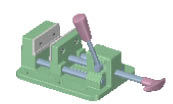 Vice assembly as a solid model, created directly from the mesh data into each related part. |
 This 2D detail sheet was created from the solid assembly for dimensioning and annotation using Geomagic Spark. | 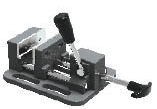 The vise assembly, rendered using the KeyShot third-party add-in available alongside Geomagic Spark. |
“The consumerization of 3D is making people much more willing to employ it in business,” notes Ralph Rio, research director with ARC Advisory Group. “Kinect is improving the knowledge and willingness of consumers to adopt 3D, and definitely helping out in the adoption of laser scanning.”
A Contrast in Technologies
Despite what many claim is the faster evolution of 3D scanners, CMMs are still widely entrenched, and are also being made over to handle the demands of modern metrology applications. Traditional CMMs are three-axis machines built on a granite slab for stability. They employ a fixed probe-like device to take a precise, specific set of point-by-point, X, Y, Z measurements.
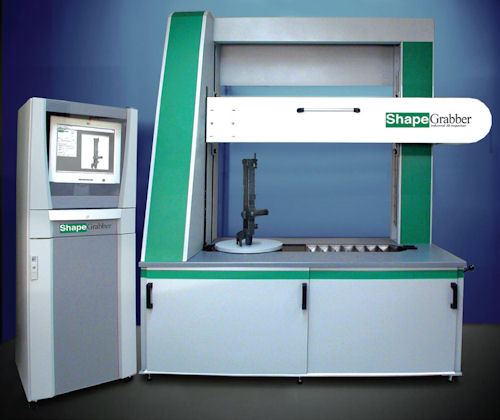 The ShapeGrabber Ai810 automated 3D laser scanner quickly scans parts that vary in size and shape, enabling it to support automated inspection applications in minutes vs. hours. Image courtesy of ShapeGrabber. |
CMMs highly trusted approach has long been lauded for its accuracy and repeatability, especially for prismatic and primitive objects such as rectangles, cylinders and cones, experts say. On the down side, CMMs require extensive programming, which demands a specific set of skills and certifications. They are not well suited for measuring complex, organic shapes, and the general consensus is that it can be difficult to communicate results beyond the pool of CMM experts because the output is too cryptic for anyone not versed in metrology science.
The current crop of CMMs is being updated with designs intended to give users more flexibility. Specifically, many CMMs can now accommodate either discrete point probes or 3D laser scanning arms—and the technology is being offered in an array of new portable form factors, including those that can be used directly on the shop floor (as opposed to requiring use only in a quality assurance laboratory).
Creaform s MetraSCAN handheld CMM |
3D laser scanners, on the other hand, take a wholly different approach. While there are variations on the technology, most 3D laser scanners work by measuring thousands of points per second to calculate the X, Y, Z coordinates for each point, then creating a digital representation of the surface of an object, typically known as a point cloud. 3D scanning s point cloud approach is garnering a lot of interest as a means of delivering a more complete picture of an entire surface of an object, metrology experts say.
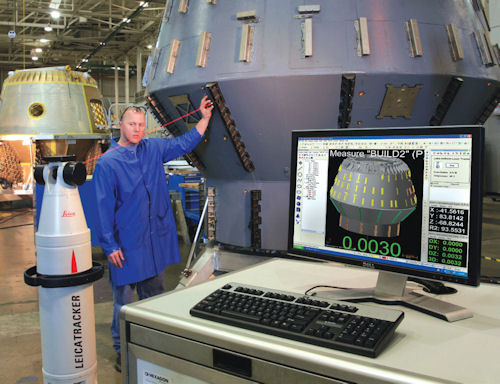 Computer monitor shows Verisurf Software controlling the Laser Tracker portable CMM used to inspect the SpaceX Dragon capsule. The software displays the in-tolerance deviation between the capsule and its respective CAD model in real-time to determine whether the capsule is assembled within specifications. Image courtesy of SpaceX. |
In addition, its streamlined integration with 3D CAD software is also viewed as an asset—especially when trying to create a seamless workflow for computer-aided first article inspection and reverse engineering applications. Applications like Geomagic s Studio and Rapidform XOR transform 3D scan data into highly accurate polygon and native CAD models, which can then be integrated into popular MCAD programs for further design and modeling work.
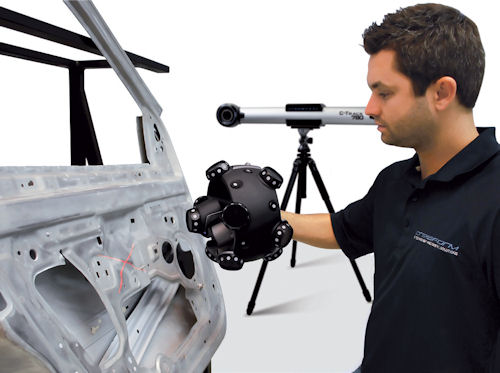 Optical CMM scanners like Creaform s arm-free, handheld MetraSCAN tackle metrology or large-scale reverse engineering applications by promising to extend measurement volumes without loss of accuracy. Image courtesy of Creaform. |
| Geomagic and SpaceClaim Spark 3D Scan Data Designs The combination of 3D scan data and 3D CAD modeling has long been the recipe for successful reverse engineering; however, the capabilities have traditionally been serviced by separate—and oftentimes, non-integrated—technologies. Geomagic, a major player in the quality inspection and metrology software arena, is seeking to change that equation with Spark, the newest addition to its product line. Unlike traditional CAD programs, which have modeling capabilities, but lack the tools to process 3D scan data into usable 3D geometry, Geomagic Spark combines a live 3D scanning interface with robust 3D point and mesh editing capabilities, along with a full-blown CAD modeling package. Specifically, Geomagic Spark integrates Geomagic s scanning technology with SpaceClaim, a popular 3D direct modeling platform. The goal is to allow users to create accurate and manufacturable solid models and assemblies using a combination of 3D scan data and 3D CAD data in the same application. The two companies, which have been collaborating since the launch of the SpaceClaim integration in the 2012 release of Geomagic Studio, saw opportunity in partnering around a fully integrated application that would alter the way users design with 3D scan data. “It s not intimidating the first time you use it,” says Kevin Scofield, senior product manager at Geomagic. “It has simple controls. You don t get lost. We were able to add a new ribbon inside of SpaceClaim that has new Capture tools.” Here s how the integrated package works: Designers scan directly into Geomagic Spark, or load an existing point cloud or polygon mesh. They then choose from a range of automated tools to convert and edit data into a polygon mesh. Once the mesh is created, Geomagic Spark s solid modeling tools—based on SpaceClaim s smart and predictive user interface—allow users to create solid geometry from the mesh, and compare the solid model to the mesh to identify areas of deviation. Scofield says there were a number of reasons why Geomagic chose to partner with SpaceClaim, including similar company cultures, size and an East Coast location. “What really sealed the deal was, once they were able to load meshes natively—that was the aha moment,” he says. “Once we saw that, we knew if we were able to add some of our tools, we d have a winning combination. Other tools we looked at can load meshes, but you can t interact with it as much.” |
“CMMs are good at telling me the size and location of holes, but if something is going on in between the points that I ve measured, the CMM can t tell me,” notes Dan Perreault, president of NeoMetrix Technologies Inc., an engineering services provider specializing in 3D scanning technology for reverse engineering and computer-aided inspection applications. “If a part passes inspection on a hole, it still might not work because a CMM only gathers a few data points—it doesn t give you a complete picture.”
Consider a quality inspection application for the inside of a car door. While a CMM probe can serve up an accurate measurement of the hinge location or other holes where things mount, it doesn t have sufficient data to pick up on imperfections in the sheet metal that might impede the door s fit.
“With a white light scanner, you can get 100% coverage, with millions of data points that show hole locations and the shape of the rest of the door,” Perreault explains. “You can also take the data from the scanner, overlay it with the original 3D CAD design, and see glaring red spots to indicate out-of-tolerance conditions and deviations.”
3D scanning can also be less labor-intensive than traditional CMMs, in terms of the actual process of recording measurements. That s according to ARC s Rio, who is projecting the worldwide market for 3D laser scanners to grow at an 8.8% annual growth rate (CAGR) from 2011 to 2016.
With a CMM, an operator has to move the probe from location to location to physically capture each point, or at least be knowledgeable enough to program the CMM to automate data capture. Not so with a 3D laser scanner, Rio says. It not only scans a large area—the hood of a car, for example—but can do so without having to be as accurate as to where you physically place the laser.
“The ability to read tens of thousands of points in a few seconds is a huge change in labor,” he explains. “You can go from a couple of hours to a few minutes for inspection.”
Simplicity and Speed
The various ease-of-use and automation features associated with 3D scanning technology are one of the primary drivers for increased adoption. Many 3D scanners are now relatively easy to operate without any programming, with some even going as far as to deliver fully automated quality inspection environments. Consider ShapeGrabber s Ai810 3D laser scanner, for example, which is designed to quickly scan parts that vary in size and shape, and perform automated inspection duties in minutes vs. hours, notes Pierre Aubrey, ShapeGrabber s CEO.
In addition to the right scanner, 3D inspection and metrology software like Geomagic Qualify is another crucial element in automating quality inspection processes, according to Bill Greene, CEO of Level 3 Inspection LLC, a provider of white light scanning and computer-aided inspection services. Level 3, which caters to manufacturers of precision products and tooling, has wholeheartedly embraced 3D scanners and Geomagic s 3D software because the combination transforms computer-aided inspection into an automated, batch process.
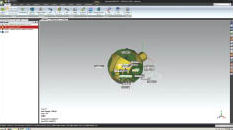 Geomagic s Qualify metrology and 3D inspection software serves as the centerpiece for Level 3 inspection s computer-aided inspection services, particularly its scanning-to-measurement process. Image courtesy of Level 3 Inspection. | 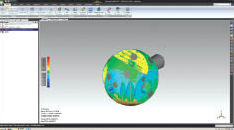 Level 3 Inspection creates a Geomagic Qualify color plot to showcase measurement deviations of the scan data from the reference data. Image courtesy of Level 3 Inspection. |
“Automation takes human error out of the equation—and it s fast,” Greene says. “You can do computer-aided inspections in 12 to 15 minutes that use to take a week or two.”
For reverse engineering applications, portability and ease-of-operation are crucial considerations. That s because it s often design engineers or researchers doing the scanning—and they are often not certified metrologists, notes Daniel Brown, product manager for 3D scanners for Creaform, a provider of portable 3D measurement solutions, including portable 3D scanners and portable CMMs.
“For the metrologist who does quality control, it s a job—and they are less concerned about time than quality and the reliability of the device,” Brown says. “For the person doing reverse engineering, they want to extract information and use it for something else, so the issue is around speed. They want a simpler, faster, more portable device.”
Laser Design s Auto Gage 3D Scanning System |
For many shops, however, it s not an either-or choice, but rather a combination of 3D scanning and CMM technology. That s certainly the case at Schneider Electric, a global manufacturer of energy transmission and automation products, which employs a two-stage process for its quality inspection processes, according to Rus Emerick, the company s global process owner for 3D imaging. Schneider Electric employs white-light 3D laser from Laser Design initially to determine whether a part is a geometric match to what was initially designed in a 3D CAD model, Emerick explains. Once that determination is made, the process is turned over to a CMM, which automatically checks the production lot of parts to ensure quality.
It s this two-stage process that sets Schneider Electric s quality inspection operation apart, Emerick maintains: “Most companies still go directly to measuring things; we have become more efficient by eliminating the need to measure parts that aren t correct. It s more efficient to use 3D scanning and Geomagic [software] to extract specific measurements out of a data set, and use CMMs for repetitive linear measurement.” DE
Beth Stackpole is a contributing editor to DE. You can reach her at [email protected].
MORE INFO
Subscribe to our FREE magazine, FREE email newsletters or both!
Latest News
About the Author
Beth Stackpole is a contributing editor to Digital Engineering. Send e-mail about this article to [email protected].
Follow DE





